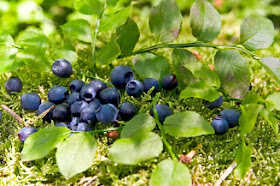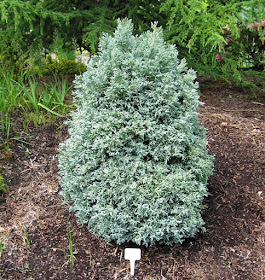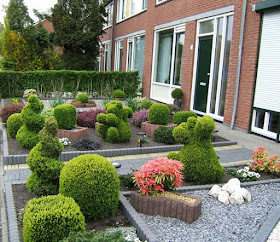Shrubs are perennial, woody plants that have multiple ecological uses and are economically important for a variety of landscape purposes. Like trees, the shrubs consist of both primary and secondary cambium (cells that ultimately form wood or bark), but unlike trees, shrubs typically have multiple stems and are somewhat shorter in height.
Native and nonnative shrubs have many uses, both in private gardens and as elements in commercial and civic landscaping. Shrubby willows and alders function as soil stabilizers, preventing erosion naturally along waterways. Other shrubs are natural wind breaks that reduce wind flow over open soils.
Farmers value shrubby wind breaks that preserve barren farm soils during fall and winter months,when the land is barren and topsoil is especially liable to be blown away during winter storms. For much the same reason, home owners may plant certain types of shrubs at strategic locations along the boundaries of the yard to reduce air flow.
  |
Many shrubs are economically important as landscape ornamentals. They are prized for the beauty, variety, pattern, and color of their leaves, buds, flowers, or fruits.
The color, shape, and texture of their leaves are all valued qualities for which shrubs are appreciated and used. Their shape, texture, pattern, and even the intricate contrast and pattern of their leafless twigs in winter can enhance the beauty and interest of a garden landscape.
Food Sources
In addition to their uses in gardens, many shrubs are important sources of foods for wildlife and for humans. Fruits of blackberries, blueberries, huckleberries, currents, gooseberries, plums, and hazelnuts are but a few of the foods obtained from shrubs. Many, such as blueberries and raspberries, are made into pies. Some currents and gooseberries are key components of jams and spreads.
 |
| blueberry shrub |
Still others, such as plums, cherries, and grapes, are eaten as fruits or used in the preparation of jams, jellies, pies, as cooking ingredients, or used for other baked goods. Some fruits are gathered only in the wild, but many others are cultivated. Cranberries, blueberries, and blackberries are cultivated varieties derived from hundreds of years of selecting and cultivating wild native shrubs.
Fruits of plums, cherries, and especially the serviceberries, or Juneberries, are used to make fine and natural wines, and it may be that serviceberries were named because they provided the earliest fruits that could be made into wines for the Eucharist during church services.
Ecologically, shrubs are also important for wildlife. They provide food, shelter, and resting and nesting areas for a wide variety of birds. For example, at least forty-six species of birds feed on elderberry fruits.
   |
Medicinal Uses
By 1812 Johann Jacob Paul Moldenhawer had shown that plant tissue was composed of independent cells, and in 1826 Henri Milne Edwards determined that all animal tissues were formed from globules.
From time immemorial, humans have enjoyed the medicinal advantages of many species of shrubs. An extract derived from the bark of willows, called salicin, is the active ingredient in one of the most important and useful of all household drugs: aspirin.
The distilled liquid from the bark of witch hazel is sold as a skin ointment. A soothing ointment is made of the oil of teaberry. Tannic acid, used for tanning leather and for medicinal purposes, was for many years obtained from the fruits of native sumacs.
Barberries
The barberries (Berberis) are a worldwide group of deciduous shrubs best known for their thorns and bright red berries. They have yellow wood and simple alternate or whorled leaves clustered on short spurs.
 |
| barberries |
Barberries were very popular land-scape ornamentals, but their reputation and use drastically decreased when they were found to be the alternate host for the black stem rust, a fungus that infects wheat. The use of hybrid varieties eliminates this ecological problem, and the barberries have once again become common as interesting and colorful ornamentals that provide good hedges, ground covers, and living barriers.
The bright red leaves make them an attractive fall shrub, while the persistent, bright red berries attractively color a yard scape through the winter months. The berries are also an important wildlife food used by a variety of birds and small mammals through the winter months.
Burning Bushes and Dogwoods
The various species of burning bushes, or Euonymous, are attractive and bushy shrubs that offer good landscape contours and contrast, but they are probably best known for their gorgeous scarlet, fire-red, or fire-pink colors during the fall season.
Dogwoods (Cornus) are shrubs or small trees that have opposite deciduous leaves and branching. A number of dogwood shrubs are useful and colorful as garden ornamentals. Chief among these are the silky dogwood (Cornus amomum) and red-osier dogwood (Cornus stolonifera), which grow in moist soil conditions.
Red-osier dogwood is the more colorful of the two shrubs, with bright red branches that provide attractive year-round landscape color, especially in winter.Almost all of the dogwoods are valuable garden shrubs for wildlife, both as nesting cover and for their fruits.
Dwarf Trees as Evergreen Shrubs
Evergreen shrubs add beauty, texture, and year round cover as ornamentals. Many species are noted for their broad leaves and showy flowers, others for the protective cover that they offer wildlife.
 |
| the cypress (Chamaecyparis) |
Many dwarf varieties of trees have also become landscape shrubs that offer year-round color, variety, and cover. Another of their properties is their remarkably slow growth, usually only a few inches a year. Dwarf trees are used as ground covers, creeping along the ground and over stone walls and fences.
Some of the many types include the cypress (Chamaecyparis), which provides dense and colorful foliage; junipers (Juniperus), which range from low growth forms to spreading forms and are able to tolerate urban and suburban conditions of low moisture and poor soils; dwarf pines (Pinus), whose long needles offer landscape and rock garden diversity; and yews (Taxus), which are commonly used for hedges and topiaries.
Of these, the prostrate or ground junipers are especially useful. These low-growing evergreen shrubs rarely reach a height greater than 3 feet but may spread in a circular mat several feet in diameter.
The horizontal stems of ground juniper burrow into the soil surface to send up numerous upright-arching stems that form a dense ground cover. The sharp and prickly points of the leaves also make this shrub useful as a protective mat or hedge.
Fruiting Shrubs
 |
| Flowering gooseberries |
In addition to cover and color,many species and varieties of shrubs offer fruits for humans and for wildlife. These include the blueberries (Vaccinium), which occur in ornamental forms and also in low, spreading varieties, and the currants and gooseberries (Ribes), which offer black, purple, red, and white berries, depending on variety or species, that can be harvested and made into jellies and jams or simply left on the shrub to attract wildlife.
The blackberries and raspberries (Rubus) are a diverse group of fruiting shrubs famous for their fruits but less desirable as garden shrubs because of their tenacious ability to spread if left untended.
However, the fruits are harvested for preserves, pies, wines, and as ingredients in breads and other baked goods. The tangled thickets or briar patches that they form can be useful both as living hedges and as wildlife cover for quail, songbirds, and a variety of mammals.
Hollies and Hydrangeas
The hollies (Ilex) and inkberries are reasonably hardy shrubs that offer year-round beauty, color, and texture as landscape ornamentals. They are best known for their lustrous, bright green leaves, intricate spiny leaf shapes, and bright red berries, and they are especially desirable as plants during the winter holidays, when holly sprigs and berries brighten both outdoor yards and indoor holiday festivities. Many species offer cover and seasonal nesting habitat for a variety of birdspecies.
Another favorite shrub is the hydrangea (Hydrangea), with its large clusters of flowers; it is available in both a compact growth form and larger varieties. Hydrangeas are most often used as decorative shrubs for shady or semi shady and moist corners of lots and buildings.
Rhododendrons and Azaleas
 |
| Rhododendron |
The large and showy flowers of rhododendrons come in purple, pink, red, and white, while azalea flowers offer additional yellow, orange, and apricot shades. Many rhododendrons are huge shrubs that are especially valuable as wild life cover and as nesting habitat for desired species, such as cardinals.
Roses
Roses (Rosa) have been cultivated for centuries and celebrated in poetry, songs, and artwork for an equally long time. They occur in an enormous number of species and varieties and in every shade of flower color except blue.
Roses have been bred into many varieties, from miniatures to ground-covering polyanthas to bush roses and floribund as to tall hybrid teas, grandifloras, and climbers.
“Old roses” and wild roses have returned to commercial markets in recent years. Prolific and relatively easy to grow in most climates, roses fill many landscape needs, from garden color to cut flowers and even living fences to protect property.
Spireas and Sumacs
Spireas (Spirea) are deciduous shrubs with small, alternate, toothed, or lobed leaves. They are popular deciduous shrubs because they are generally easy to grow and make useful hedges, mass plantings, and borders. They are also popular for their dainty clusters of spring flowers.
Many varieties are desired for their long blooms from spring through most of summer, while others are sought for their fall colors or yellowish-green foliage. Some of the spirea varieties offer low, spreading ground covers,while others are compact decorative shrubs.
The sumacs (Rhus) are shrubs or small trees that often growing thickets. Although infrequently used in gardens, several species offer both rapid growth cover in poor soils and rich fall colors.

